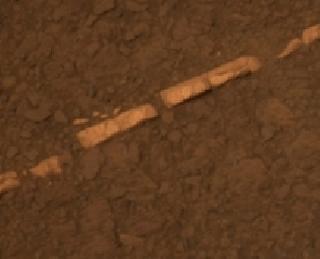
This color view of a mineral vein called "Homestake" comes from the panoramic camera on NASA's Mars Exploration Rover Opportunity. A NASA/JPL photo
PASADENA, CALIFORNIA (BNS): Scientists at NASA are thrilled by the finding of a thin bright vein of mineral on Mars which they say gives fresh evidence that water once existed on the Red Planet.
The new discovery, made by NASA rover Opportunity along the rim of the huge Martian crater Endeavour, hints at flowing water on ancient Mars.
"This tells a slam-dunk story that water flowed through underground fractures in the rock," according to Steve Squyres of Cornell University, principal investigator for Opportunity.
The mineral vein, believed to be gypsum, is about the width of a human thumb (1 to 2 centimeters), 16 to 20 inches (40 to 50 centimeters) long, and protrudes slightly higher than the bedrock on either side of it.
Observations by the rover reveal this vein and others like it within an apron surrounding a segment of the rim of Endeavour Crater. None like it were seen in the 33 kilometers of crater-pocked plains that Opportunity explored for 90 months before it reached Endeavour, nor in the higher ground of the rim, NASA said.
"This stuff is a fairly pure chemical deposit that formed in place right where we see it. That can't be said for other gypsum seen on Mars or for other water-related minerals Opportunity has found.
"It's not uncommon on Earth, but on Mars, it's the kind of thing that makes geologists jump out of their chairs," Squyres said.
A close examination of the vein, formally named "Homestake", suggests it to be gypsum, a hydrated calcium sulfate.
On Earth, gypsum is used for making drywall and plaster of Paris.
"It is a mystery where the gypsum sand on northern Mars comes from," said Opportunity science-team member Benton Clark.
"At Homestake, we see the mineral right where it formed. It will be important to see if there are deposits like this in other areas of Mars."
The scientists believe that the Homestake deposit, whether gypsum or another form of calcium sulfate, might have been formed from water dissolving calcium out of volcanic rocks.
The calcium combined with sulfur that was either leached from the rocks or introduced as volcanic gas, and it was deposited as calcium sulfate into an underground fracture that later became exposed at the surface.
Throughout Opportunity's long traverse across Mars' Meridiani plain, the rover has driven over bedrock composed of magnesium, iron and calcium sulfate minerals that also indicate a wet environment billions of years ago.
The highly concentrated calcium sulfate at Homestake could have been produced in conditions more neutral than the harshly acidic conditions indicated by the other sulfate deposits observed by Opportunity.
"It could have formed in a different type of water environment, one more hospitable for a larger variety of living organisms," Clark said.
The latest findings by Opportunity were presented on Wednesday at the American Geophysical Union's conference in San Francisco.
 Previous Article
Previous Article Next Article
Next Article













The Indian Air Force, in its flight trials evaluation report submitted before the Defence Ministry l..
view articleAn insight into the Medium Multi-Role Combat Aircraft competition...
view articleSky enthusiasts can now spot the International Space Station (ISS) commanded by Indian-American astr..
view article